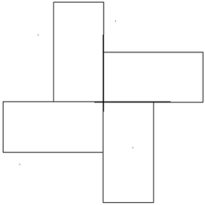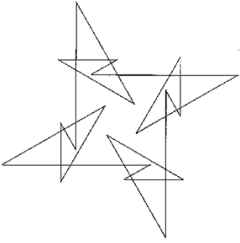


One way to describe a geometric figure is in terms of the path generated by a moving point. Instead of defining a square, for example, as a four-sided polygon with equal sides and angles, you can call it the path generated by the following rule: Go straight for a distance s, turn 90 degrees right, and repeat until the path returns to its starting point.
Using the computer language LOGO, children can produce a list of commands to govern the motion of a “turtle” and trace out a geometric track on the computer screen. Indeed, such a turtle can be programmed to generate an endless variety of patterns. Mathematicians can use similar algorithms to generate fractals and other forms.
Certain sequences of moves produce patterns known as spirolaterals. In general, the first line is one unit long, and each successive line is one unit longer than the previous one. Three factors determine the spirolateral: the turning angle, the number of segments (or turns), and the number of repetitions.
For example, a turtle could crawl a distance of one unit, turn 90 degrees right, crawl a distance of two units, turn 90 degrees right, crawl a distance of 3 units, turn 90 degrees right, then repeat the sequence. In this case, the turning angle is 90 degrees, the number of turns is 3 (so the number of segments and the order of the spirolateral is also 3), and the number of repetitions is 4 before the pattern closes up.
You can use the rules for spirolaterals “to generate artistic forms of unexpected complexity and beauty,” says Robert J. Krawcyzk of the College of Architecture at the Illinois Institute of Technology in Chicago. Krawcyzk described his investigations of spirolateral patterns at a meeting last month in Albany, N.Y., of the International Society of the Arts, Mathematics, and Architecture.
By setting different rules, you get different patterns. Some of these patterns remain open, and others close up after a certain number of repetitions. Incorporating occasional changes in direction–reversals–into the rules enlarges the repertoire of patterns in intriguing ways.
Such exercises in design can serve as idea generators for architects, Krawcyzk suggests.
They also lead to mathematical investigations–from the development of formulas for predicting when a pattern would be closed to the enumeration of all the different possibilities for a given order and turning angle, with and without reversals.
The procedure for generating spirolaterals is simple, but the patterns that arise are amazingly varied. “There’s a lot of unexpected stuff,” Krawcyzk notes.
Krawcyzk has written a JAVA module to generate and display spirolaterals, available at http://home.netcom.com/~bitart/. A visitor to the page can set the parameters, then view the result. It’s also possible to change the line thickness and add a contrasting center line to each segment of the pattern or contrasting edge lines where thickened lines intersect.
In effect, the artist (as programmer) creates the environment, and the visitor develops his or her own vision of the artwork. “The idea is the main thing, and the computer does the drawing,” Krawcyzk says.
Users can investigate all sorts of variants. “Depending on the time spent and the individual interest of the viewer, the viewer is able to see particular instances that the artist never encountered,” Krawcyzk notes.
Krawcyzk himself has printed various spirolateral designs on personalized sets of notecards. He’s planning to set up a Web-based system so that a visitor could create a design, then purchase a copy, specifying in what format and how it should be delivered to him or her.
“The next phase of this research is to review methods to create full three-dimensional sculptures or designs that begin to suggest architectural forms,” Krawcyzk says.






